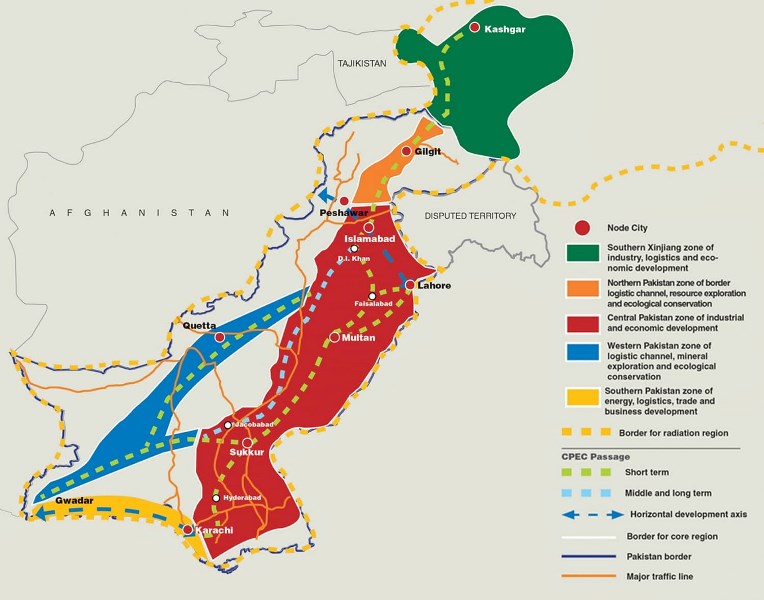Last week, President Xi Jinping at the opening ceremony of the Belt and Road forum unveiled a plan to provide about $20 billion in additional contributions to the Silk Road Fund. While Pakistan welcomed the extra funds and closer ties with China, the American Interest ran the caption “Pakistan: China’s Next Economic Colony”. Pakistani politicians are sure to object, but America is not alone in its criticism of China’s ambitious project and Pakistan’s subservient role. India is suspicious of China–Pakistan nexus and it has joined forces with Japan to build their own “strategic wall” by collaborating to promote rival infrastructure projects, and this begs the question why are so many countries uneasy about China’s Silk Road initiative?
Perhaps the answer lies in Jinping’s remarks to “foster a new type of international relations” that some have interpreted to mean a new world order fashioned by China and not the US. A few commentators subscribe to the notion that Beijing’s motive behind the Belt and Road project is to displace the US as the determinant power in Eurasia. To comprehend the implications of such a political move, more precisely China’s domination of Eurasia, a quick review of geopolitical theory is necessary.
In geopolitics, the role of geography is to paramount in understanding a country’s foreign policy. To understand the spatial politics of Eurasia, two alternative perspectives in Eurasia must be understood. In 1904, British geographer, Halford Mackinder, published an article called “The Geographical Pivot of History” in which he outlined the Heartland theory. The central premise of this theory can be summed up as “Who rules East Europe commands the Heartland; who rules the Heartland commands the World-Island (Europe, Asia and Africa); who rules the World-Island commands the world.” According to Mackinder, the Heartland consists of Eastern Europe and Asia which is also known as the pivot area. Mackinder identified land mass powers, such as Germany and Russia, to dominate world politics. Mackinder’s predictions saw some success with the Soviet Union.
US strategist, Spykman, popularized the Rimland theory which maintains that the band of coastal lands that encircle Eurasia is more significant than the heartland in deciding the future of Europe, Asia and Africa. In Spykman’s view, a nation’s sea power as opposed to land power would decide the fate of Eurasia. According to this thesis, it is essential for a sea powering nation to have influence from the Arabian Gulf countries all the way to Japan. By doing so, land mass powers, such as Russia and to a lesser extent China, could be contained. These two theories greatly influenced US foreign policy makers, and modern-day US thinkers like Kissinger and Brzezinski used variations of Mackinder and Spykman to espouse concepts like balkanization, arc of instability and the importance of the Asian Pacific Rim amongst other ideas.
It can be argued that Germany’s containment through NATO, the inability of the European Union to challenge American primacy, the defeat of the Soviet Union in Afghanistan, instability in the Middle East and the current crisis in Korean peninsula are all part of American policy successes derived from the application of the two geopolitical theories.
Like with all theories, it is difficult to keep their contents secret, and eventually adversaries will learn to adapt or even take over. A scrutiny of China’s Belt and Road endeavor indicates that Beijing is looking to establish the means to enable China to pivot into a great power with global reach. China is aiming to control both the heartland as well as the rim land through these ambitious projects. For instance, CPEC will assist China to ship goods from the Arabian Gulf through the port of Gwadar in Pakistan via railway links to the Karakorum highway and the onto mainland China. Pakistan is only one piece of China’s Maritime Silk Road— part of the Belt and Road initiative—project, and it appears to be an attempt to control rim land ports. This not only aids China to circumvent shipping lanes controlled by America but additionally prepares Beijing to exploit such ports for military purposes to contest American hegemony. Unlike Russia, China is not hemmed in by the density of the heartland and has grown sea legs in an effort to match the traits of a sea power.
The irony of these geopolitical maneuvers by great powers is that the Muslim world, endowed with immense capabilities, is unable to partake in this struggle and decide its own fate. On the contrary, Muslim resources, like ports, roads, soldiers, hydrocarbons, waterways and so forth, are all put to the service of great powers to imprison Muslims masses in Eurasia. Rather than using the same resources and tools to liberate Muslims from Central Asia to East Turkestan, and from the Middle East to Africa, the rulers of the Muslim world see no shame in capitulating before the great powers and acquiescing to their every whim.
The Islamic state of the past was unique in every way. It was both a land power as well as a sea power, and enjoyed unrivalled primacy over the lands of Eurasia for a thousand years. Unless Muslims unite under the banner of Khilafah Rashidah (Righteous Caliphate), the Muslim Ummah will remain subdued and oppressed by the great powers.
Abdul Majeed Bhatti
Written for Ar-Rayah Newspaper – Issue 132

